
News Archive

Scientists propose new way to probe dark energy
Cosmologists from Princeton University have a new method to understand why the expansion of the universe is speeding up. The proposed technique will be able to determine if the cosmic acceleration is due to a yet unknown form of "dark energy" in the universe or if it is a signature of a breakdown of Einstein's theory of General Relativity at very large scales of the universe.
 FULL STORY FULL STORY
 |  |

|
 |
Satellite plays hide and seek with exoplanet
MOST, Canada's first space telescope, has turned up an important clue about the atmosphere and cloud cover of a mysterious planet around another star, by playing a cosmic game of 'hide and seek' as that planet moves behind its parent star in its orbit.
 FULL STORY FULL STORY
 |  |

|
 |
'Tail wagging dog' seen in star-exoplanet system
Astronomers using the MOST space telescope have observed a remarkable planetary system where a giant close-in planet is forcing its parent star to rotate in lock-step with the planet's orbit.
 FULL STORY FULL STORY
 |  |

|
 |
CloudSat spacecraft delivered to Vandenberg
A NASA spacecraft designed to reveal the inner secrets of Earth's clouds has arrived at Vandenberg
Air Force Base, Calif., to begin final launch preparations.
 FULL STORY FULL STORY
 |  |

|
 |
Canadian astronomers look deep into stellar cocoon
Using a giant telescope on Mauna Kea Hawaii is a dream for most amateur sky watchers. Recently a Canadian amateur astronomy group took advantage of a rare opportunity and used one of the largest telescopes in the world, the Gemini 8-meter telescope, to look more deeply into the remains of a particular stellar nursery than anyone ever has.
 FULL STORY FULL STORY
 |  |

|
 |
Comet-hitting probe tweaks its course to target
Fifty-nine days before going head-to-head with comet Tempel 1, NASA's Deep Impact spacecraft successfully executed the second trajectory correction maneuver of the mission.
 FULL STORY FULL STORY
 |  |

|
 |
Mars' South Pole mystery
NASA scientists have solved an age-old mystery by finding that Mars' southern polar cap is offset from its geographical south pole because of two different polar climates.
 FULL STORY FULL STORY
 |  |
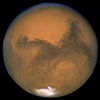
|
 |
ISS and shuttle crew members selected
NASA and its international partners have named new crew members for upcoming missions to the International Space Station. U.S. astronaut Bill McArthur and Russian cosmonaut Valery Tokarev will serve on the station as the crew of Expedition 12, launching on Soyuz later this year. Thomas Reiter, a European Space Agency astronaut, will also carry out a long-duration mission on the station. He will launch aboard shuttle Atlantis.
 FULL STORY FULL STORY
 |  |
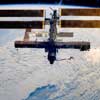
|
 |
Great white splat
Looking closely at Saturn's moon Rhea during a somewhat distant flyby, Cassini provides this view of what appears to be a bright, rayed and therefore relatively young crater.
 FULL STORY FULL STORY
 |  |

|
 |
New observation reveals Titan's atmosphere
Titan's atmospheric winds, temperature and mixing have been revealed by new observations from the Cassini spacecraft. The thick atmosphere of Saturn's giant moon is rich in organic compounds, whose chemistry may be similar to that which occurred on Earth before the emergence of life.
 FULL STORY FULL STORY
 |  |
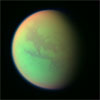
|
 |
Mars probe uses solar heating to fix boom glitch
Scientists around the world can breathe easier after engineers devised a fix to lock a 65-foot radar boom in place aboard Europe's Mars Express probe in orbit around the Red Planet.
 FULL STORY FULL STORY
 |  |

|
 |
Telescope penetrates heart of most powerful explosion
Astronomers have penetrated the heart of the universe's most powerful explosion - a gamma-ray burst. Using the PAIRITEL robotic telescope on Mt. Hopkins, Arizona, they detected a flash of infrared light accompanying the burst of high-energy radiation that signaled the death of a star 15 times more massive than the Sun.
 FULL STORY FULL STORY
 |  |

|
 |
Unique cosmic burst caught
NASA scientists have, for the first time, detected and pinned down the location of a short gamma-ray burst, lasting only 50 milliseconds. The burst marks the birth of a black hole. The astronomy community is speculating on what may have caused the burst; perhaps a collision of two older black holes or two neutron stars.
 FULL STORY FULL STORY
 |  |
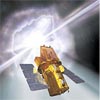
|
 |
Cassini finds new Saturn moon that makes waves
In a spectacular kick-off to its first season of prime ring viewing, which began last month, the Cassini spacecraft has confirmed earlier suspicions of an unseen moon hidden in a gap in Saturn's outer A ring. A new image and movie show the new moon and the waves it raises in the surrounding ring material.
 FULL STORY FULL STORY
 |  |

|
 |
Chandra space observatory catches X-ray super-flares
New results from NASA's Chandra X-ray Observatory about the Orion Nebula imply super-flares torched our young solar system. Such X-ray flares likely affected the planet-forming disk around the early sun, and may have enhanced the survival chances of Earth.
 FULL STORY FULL STORY
 |  |

|
 |
Next GPS satellite launch delayed to mid-June
A handful of worries spawned by problems found in the factory have prompted the Air Force to delay launching the next Global Positioning System satellite.
 FULL STORY FULL STORY
 |  |
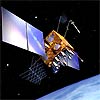
|
 |
Discovery's mission plan
Our detailed look at the daily work aboard space shuttle Discovery's mission has been updated to reflect the new July target launch date and time. Other comprehensive charts, including the launch and landing timelines, launch windows and key personnel, have been updated too.
 MASTER FLIGHT PLAN MASTER FLIGHT PLAN
 MISSION QUICKLOOK MISSION QUICKLOOK
 LAUNCH WINDOWS CHART LAUNCH WINDOWS CHART
 LAUNCH EVENTS TIMELINE LAUNCH EVENTS TIMELINE
 ENTRY AND LANDING TIMELINE ENTRY AND LANDING TIMELINE
 KEY MISSION PERSONNEL KEY MISSION PERSONNEL
 |  |

|
 |
XMM-Newton sees 'hot spots' on neutron stars
Thanks to data from ESA's XMM-Newton spacecraft, European astronomers have observed for the first time rotating "hot spots" on the surfaces of three nearby neutron stars.
 FULL STORY FULL STORY
 |  |

|
 |
OTHER HEADLINES Additional stories today
|
 |
Success in XTAR's first trials of X-band system -- XTAR announced that it has successfully completed its first field trials of the XTAR-EUR satellite for the U.S. Army's 7th Signal Brigade, based at the Army's Sullivan Barracks in Mannheim, Germany.
|
 |
Global weather-tracking satellite to launch mid-week
Taking the pulse of our planet's health and detecting clues needed for weather forecasts have been the chief tasks for Earth-orbiting weather observatories over the past four decades, and that legacy will be extended this week when the latest spacecraft blasts off from California.
 FULL STORY FULL STORY
 |  |

|
 |
Mars Express radar boom deployment hits snag
The deployment of the second antenna boom of the Mars Express Sub-Surface Sounding Radar Altimeter (MARSIS) science experiment aboard the European orbiter has been delayed pending investigation of an anomaly found during deployment of the first antenna boom.
 FULL STORY FULL STORY
 |  |
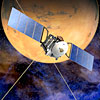
|
 |
Scientists discover Pluto kin is member of Saturn family
Saturn's battered little moon Phoebe is an interloper to the Saturn system from the deep outer solar system, scientists have concluded.
 FULL STORY FULL STORY
 |  |

|
 |
Earth's energy imbalance confirmed by scientists
Scientists have concluded more energy is being absorbed from the sun than is emitted back to space, throwing the Earth's energy "out of balance" and warming the globe.
 FULL STORY FULL STORY
 |  |

|
 |
Mars rover finds itself ditched in sandy terrain
NASA's rover Opportunity has spun its wheels in a small dune, prompting extensive testing on Earth to determine how to get the craft freed.
 FULL STORY FULL STORY
 |  |

|
 |
Shuttle Discovery will switch to new fuel tank
NASA managers have decided to stage a second tanking test next weekend or shortly after to troubleshoot problems with the shuttle Discovery's external fuel tank. The shuttle then will be hauled back to the Vehicle Assembly Building where engineers will attach the ship to a different set of boosters and a fresh external tank, officials said late Friday.
 FULL STORY - updated Friday night FULL STORY - updated Friday night
 |  |

|
 |
Has orbiter found NASA's lost Mars Polar Lander?
NASA's Mars Polar Lander disappeared as it arrived at the Red Planet in December 1999. Lacking any telemetry from the spacecraft, investigators could not pin-point with great certainty what caused the failure. Now, the orbiting Mars Global Surveyor satellite has apparently discovered the crash site.
 FULL STORY FULL STORY
 |  |

|
 |
Spitzer observatory spies spectacular Sombrero
NASA's Spitzer Space Telescope set its infrared eyes on one of the most famous objects in the sky, Messier 104, also called the Sombrero galaxy. In this striking infrared picture, Spitzer sees an exciting new view of a galaxy that in visible light has been likened to a "sombrero," but here looks more like a "bulls-eye."
 FULL STORY FULL STORY
 |  |

|
 |
Cassini shows amazing icy moons of Saturn
A scene straight out of science fiction, this fantastic view shows Saturn's moon's Mimas, Dione and Rhea, on the far side of Saturn's nearly edge-on rings.
 FULL STORY FULL STORY
 |  |

|
 |
India launches 3-D land mapping spacecraft
The newest member of India's Earth-watching satellite constellation roared away from a brand new launch pad this morning to kick off a mission planned to generate precise maps for use in a wide variety of disciplines.
 FULL STORY FULL STORY
 |  |

|
 |
Engineers assess space shuttle launch schedule
The shuttle Discovery's crew strapped in Wednesday for a dress rehearsal countdown while program managers continued assessing what work needs to be done - and whether it can be completed in time - for a July 13 launch attempt.
 FULL STORY FULL STORY
 |  |
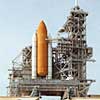
|
 |
Shuttle launch countdown rehearsal completed
Space shuttle Discovery's seven astronauts have climbed aboard their spaceship at launch pad 39B Wednesday morning for the final three hours of a mock countdown that ended with a simulated main engine shutdown and crew evacuation.
 MISSION STATUS CENTER MISSION STATUS CENTER
 |  |

|
 |

Additional coverage for subscribers:
 VIDEO:
COLLINS TALKS TO REPORTERS AFTER THE COUNTDOWN QT VIDEO:
COLLINS TALKS TO REPORTERS AFTER THE COUNTDOWN QT
 VIDEO:
COUNTDOWN ENDS WITH SIMULATED ENGINE SHUTDOWN QT VIDEO:
COUNTDOWN ENDS WITH SIMULATED ENGINE SHUTDOWN QT
 VIDEO:
WATCH T-9 MINUTES THOUGH POST-ABORT SAFING QT VIDEO:
WATCH T-9 MINUTES THOUGH POST-ABORT SAFING QT
 VIDEO:
COMMANDER COLLINS CLIMBS TO HER FLIGHT DECK SEAT QT VIDEO:
COMMANDER COLLINS CLIMBS TO HER FLIGHT DECK SEAT QT
 VIDEO:
ASTROVAN ARRIVES AT PAD; CREW HEADS UP ELEVATOR QT VIDEO:
ASTROVAN ARRIVES AT PAD; CREW HEADS UP ELEVATOR QT
 VIDEO:
ASTRONAUTS DEPART QUARTERS FOR LAUNCH PAD QT VIDEO:
ASTRONAUTS DEPART QUARTERS FOR LAUNCH PAD QT
 VIDEO:
CREWMEMBERS DON THEIR LAUNCH SPACESUITS QT VIDEO:
CREWMEMBERS DON THEIR LAUNCH SPACESUITS QT
 VIDEO:
ASTRONAUTS SEATED FOR BREAKFAST TODAY QT VIDEO:
ASTRONAUTS SEATED FOR BREAKFAST TODAY QT
 VIDEO:
FOOTAGE OF THIS WEEK'S KSC TRAINING QT VIDEO:
FOOTAGE OF THIS WEEK'S KSC TRAINING QT

 VIDEO:
TUESDAY'S CREW CHAT AT PAD DIAL-UP | BROADBAND VIDEO:
TUESDAY'S CREW CHAT AT PAD DIAL-UP | BROADBAND
 VIDEO:
COMMANDER COLLINS ADDRESSES THE MEDIA SUNDAY QT VIDEO:
COMMANDER COLLINS ADDRESSES THE MEDIA SUNDAY QT
 VIDEO:
PREVIEW OF DISCOVERY'S MISSION DIAL-UP | BROADBAND VIDEO:
PREVIEW OF DISCOVERY'S MISSION DIAL-UP | BROADBAND
 VIDEO:
THE SPACE STATION WITHOUT SHUTTLE DIAL-UP | BROADBAND VIDEO:
THE SPACE STATION WITHOUT SHUTTLE DIAL-UP | BROADBAND
 VIDEO:
MEET DISCOVERY'S SEVEN ASTRONAUTS DIAL-UP | BROADBAND VIDEO:
MEET DISCOVERY'S SEVEN ASTRONAUTS DIAL-UP | BROADBAND
 SUBSCRIBE NOW SUBSCRIBE NOW

|
Rock hounds sleuth rise of Earth's atmosphere
"CSI-like" techniques, used on minerals, are revealing the steps that led to evolution of the atmosphere on Earth. Studies over the last five years have led to a growing consensus by the scientific community of what happened to produce the protective ozone layer and atmosphere on our planet.
 FULL STORY FULL STORY
 |  |
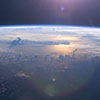
|
 |
ILS Proton rocket picked to launch SIRIUS 4 satellite
Nordic Satellite AB announced today that the launch of its SIRIUS 4 satellite will be on a Proton Breeze M booster provided by International Launch Services. Terms of the contract remain confidential.
 FULL STORY FULL STORY
 |  |

|
 |
Boeing, Lockheed to form rocket launch venture
Boeing and Lockheed Martin have entered into an agreement to create a joint venture that will combine the production, engineering, test and launch operations associated with U.S. government launches of Delta and Atlas rockets. The joint venture, named United Launch Alliance, will reduce the cost of meeting the critical national security and NASA expendable launch vehicle needs of the United States.
 READ THE ANNOUNCEMENT READ THE ANNOUNCEMENT
 |  |

|
 |
Channels on Titan?
It's hard not to speculate about the origins of the narrow, dark features seen in Cassini's new images of Titan's surface. They tantalize the viewer, resembling the dark channels seen elsewhere on Titan, but are just at the limits of resolution of the images -- too close to identify their true nature.
 FULL STORY FULL STORY
 |  |

|
 |
Saturn's moon Titan is complex 'anti-greenhouse'
This natural color image shows Titan's upper atmosphere -- an active place where methane molecules are being broken apart by solar ultraviolet light and the byproducts combine to form compounds like ethane and acetylene. The haze preferentially scatters blue and ultraviolet wavelengths of light, making its complex layered structure more easily visible at the shorter wavelengths used in this image.
 FULL STORY FULL STORY
 |  |

|
 |
Mars Express radar package to be deployed
The European Space Agency's Mars Express orbiter will soon deploy its radar instrument for the first time. The instrument is designed to look below the surface of Mars for different layers of material, most notably water.
 FULL STORY FULL STORY
 |  |

|
 |
Photo gallery: Cape's final Titan rocket lifts off
This collection of photos captures Friday night's Titan 4 rocket launch from Cape Canaveral as seen from the press viewing site on the NASA Causeway and sound-activated cameras placed around Complex 40.
 ENTER GALLERY ENTER GALLERY
 |  |

|
 |
Discovery astronauts ready to practice countdown
As space shuttle Discovery's astronauts jetted into Kennedy Space Center Sunday night for their launch countdown dress rehearsal, mission commander Eileen Collins voiced support for NASA's decision to delay liftoff until July.
 FULL STORY FULL STORY
 |  |

|
 |

Additional coverage for subscribers:
 VIDEO:
WATCH COLLINS' ADDRESS TO THE MEDIA SUNDAY NIGHT QT VIDEO:
WATCH COLLINS' ADDRESS TO THE MEDIA SUNDAY NIGHT QT
 SUBSCRIBE NOW SUBSCRIBE NOW

|
Cassini captures swiss-cheese look of Saturn moon
An image of Saturn's small moon, Epimetheus, was captured by the Cassini spacecraft in the closest view ever taken of the pockmarked body. Epimetheus is irregularly shaped and dotted with soft-edged craters. The many large, softened craters on Epimetheus indicate a surface that is several billion years old.
 FULL STORY FULL STORY
 |  |

|
 |
Reality realized: Titan has left Cape Canaveral
Cape Canaveral said goodbye to the Titan rocket family after five decades and 168 thunderous launches Friday night when the program's largest booster pierced a star-filled sky and disappeared forever.
 FULL STORY FULL STORY
 SEE A FREE PREVIEW OF THE LAUNCH VIDEO SEE A FREE PREVIEW OF THE LAUNCH VIDEO
 |  |

|
 |
Titan 4 apparently launched radar-imaging satellite
A sophisticated radar-imaging spy satellite is what the Titan 4B rocket launched Friday night, according to sharp-eyed sky watchers who spotted the spacecraft literally minutes after blastoff.
 MISSION STATUS CENTER MISSION STATUS CENTER
 LAUNCH PREVIEW STORY LAUNCH PREVIEW STORY
 WORKERS' UNCERTAIN FUTURE WORKERS' UNCERTAIN FUTURE
 |  |

|
 |

Additional coverage for subscribers:
 VIDEO:
FLIGHT OF THE TITAN: LAUNCH TO SRM SEPARATION QT VIDEO:
FLIGHT OF THE TITAN: LAUNCH TO SRM SEPARATION QT
 VIDEO:
THE CAPE'S LAST TITAN 4 ROCKET BLASTS OFF QT VIDEO:
THE CAPE'S LAST TITAN 4 ROCKET BLASTS OFF QT

 VIDEO:
"SALUTE TO TITAN" MOVIE QT VIDEO:
"SALUTE TO TITAN" MOVIE QT
 VIDEO:
FOOTAGE OF PAST TITAN LAUNCHES FROM 1950S TO TODAY QT VIDEO:
FOOTAGE OF PAST TITAN LAUNCHES FROM 1950S TO TODAY QT
 VIDEO:
THIS TITAN 4 ROCKET EMERGES FROM ASSEMBLY BUILDING QT VIDEO:
THIS TITAN 4 ROCKET EMERGES FROM ASSEMBLY BUILDING QT
 VIDEO:
THE ROCKET ARRIVES AT COMPLEX 40 LAST AUGUST QT VIDEO:
THE ROCKET ARRIVES AT COMPLEX 40 LAST AUGUST QT
 VIDEO:
VIEWS OF THE TITAN 4 ON THE PAD AFTER SUNRISE QT VIDEO:
VIEWS OF THE TITAN 4 ON THE PAD AFTER SUNRISE QT
 SUBSCRIBE NOW SUBSCRIBE NOW

|
Shuttle launch on ice while NASA ponders tank changes
The shuttle Discovery's launch on the first post-Columbia mission is on ice until at least July 13, officials said Friday, primarily because of recent tests showing ice buildups pose more of a potential impact threat than previously thought.
 FULL STORY FULL STORY
 MISSION STATUS CENTER MISSION STATUS CENTER
 EARLIER STORY EARLIER STORY
 STORE: OFFICIAL MISSION PATCH STORE: OFFICIAL MISSION PATCH
 |  |

|
 |

Additional coverage for subscribers:
 VIDEO:
NASA ADMINISTRATOR ANNOUNCES THE DELAY QT VIDEO:
NASA ADMINISTRATOR ANNOUNCES THE DELAY QT
 SUBSCRIBE NOW SUBSCRIBE NOW

|
'Wonderful' star reveals its hot nature
For the first time an X-ray image of a pair of interacting stars has been made by NASA's Chandra X-ray Observatory. The ability to distinguish between the interacting stars - one a highly evolved giant star and the other likely a white dwarf - allowed a team of scientists to observe an X-ray outburst from the giant star and find evidence that a bridge of hot matter is streaming between the two stars.
 FULL STORY FULL STORY
 |  |

|
 |
Comet-bound Deep Impact spacecraft spots its target
Sixty-nine days before it gets up-close-and-personal with a comet, NASA's Deep Impact spacecraft successfully photographed its quarry, comet Tempel 1, at a distance of 39.7 million miles.
 FULL STORY FULL STORY
 |  |

|
 |
Cassini finds particles near Saturn's moon Enceladus
The Cassini spacecraft has discovered intriguing dust particles around Saturn's moon Enceladus. The particles might indicate the existence of a dust cloud around Enceladus, or they may have originated from Saturn's outermost ring, the E-ring.
 FULL STORY FULL STORY
 |  |

|
 |
Organic materials spotted high above Titan's surface
During its closest flyby of Saturn's moon Titan earlier this month, the Cassini spacecraft found that the outer layer of the thick, hazy atmosphere is brimming with complex hydrocarbons. Scientists believe that Titan's atmosphere may be a laboratory for studying the organic chemistry that preceded life and provided the building blocks for life on Earth.
 FULL STORY FULL STORY
 |  |

|
 |
Sea Launch propels DIRECTV satellite into space
The first of several new satellites to substantially expand the high-definition channel offering by direct-to-home television broadcaster DIRECTV successfully rocketed into Earth orbit Tuesday morning.
 MISSION STATUS CENTER MISSION STATUS CENTER
 |  |

|
 |
Hubble shows stellar spire in the Eagle Nebula
Appearing like a winged fairy-tale creature poised on a pedestal, this object is actually a billowing tower of cold gas and dust rising from a stellar nursery called the Eagle Nebula. The soaring tower is 9.5 light-years or about 57 trillion miles high, about twice the distance from our Sun to the next nearest star.
 FULL STORY FULL STORY
 |  |

|
 |
The Whirlpool Galaxy and companion
The graceful, winding arms of the majestic spiral galaxy M51 appear like a grand spiral staircase sweeping through space. They are actually long lanes of stars and gas laced with dust. This sharpest-ever image of the Whirlpool Galaxy was taken with the Advanced Camera for Surveys aboard NASA's Hubble Space Telescope.
 FULL STORY FULL STORY
 |  |

|
 |
Space Shuttle History:
The launch of Hubble
This retrospective remembers the birth of Hubble. Space shuttle Discovery successfully delivered NASA's Hubble Space Telescope into Earth orbit in April 1990. The observatory opened a new window on the universe, revolutionizing our understanding of the cosmos.
 FULL VIDEO COLLECTION FULL VIDEO COLLECTION
 |  |

|
 |
Station's Expedition 10 crew returns to Earth
The departing crew of the international space station safely returned to Earth aboard a Russian Soyuz capsule Sunday, closing out a six-month stay in space with a spectacular re-entry into the atmosphere.
 FULL STORY FULL STORY
 MISSION STATUS CENTER MISSION STATUS CENTER
 |  |

|
 |

Additional coverage for subscribers:
 VIDEO:
FIERY RE-ENTRY OF SOYUZ AS SEEN FROM SPACE QT VIDEO:
FIERY RE-ENTRY OF SOYUZ AS SEEN FROM SPACE QT
 VIDEO:
SOYUZ UNDOCKS FROM STATION QT VIDEO:
SOYUZ UNDOCKS FROM STATION QT
 VIDEO:
SUNDAY'S FAREWELL CEREMONY QT VIDEO:
SUNDAY'S FAREWELL CEREMONY QT
 VIDEO:
CHANGE OF COMMAND CEREMONY ABOARD ISS QT VIDEO:
CHANGE OF COMMAND CEREMONY ABOARD ISS QT
 VIDEO:
EXPEDITION 10 RECAP NEWS CONFERENCE QT VIDEO:
EXPEDITION 10 RECAP NEWS CONFERENCE QT
 AUDIO:
LISTEN TO THE NEWS BRIEFING QT AUDIO:
LISTEN TO THE NEWS BRIEFING QT
 SUBSCRIBE NOW SUBSCRIBE NOW

|
Galaxy clusters, near and far, have a lot in common
Using two orbiting X-ray telescopes, a team of international astronomers has examined distant galaxy clusters in order to compare them with their counterparts that are relatively close by.
 FULL STORY FULL STORY
 |  |

|
 |
Nine new flight directors appointed in Houston
NASA has named nine new flight directors who will join a unique group of individuals that lead human space flights from Mission Control, Houston. It is the second largest such class ever selected, and brings to 30 the number of active Space Shuttle and International Space Station flight directors.
 FULL STORY FULL STORY
 |  |

|
 |
Cassini produces three stunning new views of Titan
These three views of Saturn's moon Titan from the Cassini spacecraft illustrate how different the same place can look in different wavelengths of light. Cassini's cameras have numerous filters that reveal features above and beneath the shroud of Titan's atmosphere.
 FULL STORY FULL STORY
 |  |

|
 |
Silhouette reveals hidden shape of star's envelope
Detailed new images of the starbirth nursery in the Omega Nebula have revealed a multi component structure in the envelope of dust and gas surrounding a very young star. The stellar newborn, called M17-SO1, has a flaring torus of gas and dust, and thin conical shells of material above and below the torus.
 FULL STORY FULL STORY
 |  |

|
 |
Spitzer telescope sees signs of alien asteroid belt
NASA's Spitzer Space Telescope has spotted what may be the dusty spray of asteroids banging together in a belt that orbits a star like our Sun. The discovery offers astronomers a rare glimpse at a distant star system that resembles our home, and may represent a significant step toward learning if and where other Earths form.
 FULL STORY FULL STORY
 |  |

|
 |
NASA says key Genesis science collectors are OK
Scientists have closely examined four Genesis spacecraft collectors, vital to the mission's top science objective, and found them in excellent shape, despite the spacecraft's hard landing last year.
 FULL STORY FULL STORY
 |  |

|
 |
Titan 4 rocket could launch from Cape late next week
With a little ingenuity, elbow grease and help from 3,000 miles away, the Titan 4 rocket team is working to overcome ground equipment headaches that have kept the big booster bolted to its Cape Canaveral launch pad this month instead of flying a classified national security space mission.
 FULL STORY FULL STORY
 |  |

|
 |
Space shuttle launch date postponed a week
As expected, NASA managers Wednesday announced a May 22 target date for shuttle Discovery's liftoff on the first post-Columbia mission, saying time needed to close out a handful of open issues precluded an attempt at the May 15 opening of the actual launch period.
 FULL STORY FULL STORY
 MISSION STATUS CENTER - updates MISSION STATUS CENTER - updates
 SCHEDULE OF EVENTS AHEAD SCHEDULE OF EVENTS AHEAD
 LAUNCH WINDOWS CHART LAUNCH WINDOWS CHART
 UPDATED MASTER FLIGHT PLAN UPDATED MASTER FLIGHT PLAN
 STORE: OFFICIAL MISSION PATCH STORE: OFFICIAL MISSION PATCH
 |  |

|
 |
Cosmic shell-seekers find a beauty thanks to Chandra
This image, made by combining 150 hours of archived Chandra X-ray Observatory data, shows the remnant of a supernova explosion. The central bright cloud of high-energy electrons is surrounded by a distinctive shell of hot gas.
 FULL STORY FULL STORY
 |  |

|
 |
Mystery of extrasolar planets' eccentric orbits
Except for the fact that we call it home, for centuries astronomers didn't have any particular reason to believe that our solar system was anything special in the universe. But, beginning with the discovery 10 years ago of the first planet outside our solar system, evidence suggests that, as far as planetary systems go, the solar system might be special indeed.
 FULL STORY FULL STORY
 |  |

|
 |
Dark patch on Saturn's moon Rhea seen by Cassini
The ancient and battered surface of Saturn's moon Rhea shows a notable dark swath of territory near the eastern limb in this image from Cassini.
 FULL STORY FULL STORY
 |  |

|
 |
Griffin talks shuttle launch decision in news briefing
New NASA Administrator Michael Griffin said Monday he would consider pressing ahead with launch of shuttle Discovery next month even if an outside review panel found fault with NASA's implementation of post-Columbia safety upgrades.
 FULL STORY FULL STORY
 |  |

|
 |

Additional coverage for subscribers:
 VIDEO:
WATCH GRIFFIN'S FIRST NEWS CONFERENCE QT VIDEO:
WATCH GRIFFIN'S FIRST NEWS CONFERENCE QT
 SUBSCRIBE NOW SUBSCRIBE NOW

|
Impact basins reveal the ancient equator of Mars
Since the time billions of years ago when Mars was formed, it has never been a spherically symmetric planet, nor is it composed of similar materials throughout, say scientists who
have studied the planet.
 FULL STORY FULL STORY
 |  |

|
 |
Sister moons of Saturn
Cassini offers this lovely comparison between two of Saturn's satellites, Dione and Tethys, which are similar in size but have very different surfaces. Extensive systems of bright fractures carve the surface of Dione. In contrast, the surface of Tethys appears brighter and more heavily cratered.
 FULL STORY FULL STORY
 |  |

|
 |
A bubble bursts
RCW 79 is seen in the southern Milky Way, 17,200 light-years from Earth in the constellation Centaurus in this spectacular image from the Spitzer Space Telescope. The bubble is 70-light years in diameter, and probably took about one million years to form from the radiation and winds of hot young stars.
 FULL STORY FULL STORY
 |  |

|
 |
Stunning view of Saturn's moon Enceladus
Saturn's bright moon Enceladus hovers here, in front of rings darkened by the planet's shadow. This view is from less than one degree beneath the ring plane. The dark shadow first takes a bite out of the rings at the right, where the distant, outermost ring material appears to taper and fade.
 FULL STORY FULL STORY
 |  |

|
 |
Scientists think you'd be "roasted" in a black hole
Contrary to established scientific thinking, you'd be roasted and not "spaghettified" if you stumbled into a supermassive black hole. New research presented at the Institute of Physics conference Physics 2005 took a new look at the diet of the universe's most intriguing object, black holes.
 FULL STORY FULL STORY
 |  |

|
 |
NASA space autopilot test suffers crippling flaw
NASA's $110 million high-risk, high-tech demonstration of a space autopilot for future human spaceships and robotic cargo craft closed within 300 feet of its target Friday night, then inexplicably ran out of fuel to the dismay of helpless engineers on the ground.
 FULL STORY FULL STORY
 MISSION STATUS CENTER MISSION STATUS CENTER
 |  |
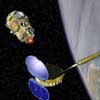
|
 |

Additional coverage for subscribers:
 VIDEO:
L-1011 CARRIER JET TAKES OFF FROM VANDENBERG QT VIDEO:
L-1011 CARRIER JET TAKES OFF FROM VANDENBERG QT
 VIDEO:
PEGASUS ROCKET LAUNCHES DART SHORT | FULL LENGTH VIDEO:
PEGASUS ROCKET LAUNCHES DART SHORT | FULL LENGTH
 VIDEO:
POST-LAUNCH COMMENTS FROM NASA MANAGER QT VIDEO:
POST-LAUNCH COMMENTS FROM NASA MANAGER QT
 VIDEO:
NARRATED FOOTAGE OF PRE-FLIGHT CAMPAIGN QT VIDEO:
NARRATED FOOTAGE OF PRE-FLIGHT CAMPAIGN QT
 SUBSCRIBE NOW SUBSCRIBE NOW

|
Soyuz docks to station
A Russian Soyuz capsule carrying the international space station's 11th long-duration crew docked with the lab complex late Saturday after a trouble-free two-day orbital chase that began with launch Thursday from the Baikonur Cosmodrome in Kazakhstan.
 FULL STORY FULL STORY
 MISSION STATUS CENTER MISSION STATUS CENTER
 |  |

|
 |
Early universe was packed with mini black holes
A research group at Cambridge think that the universe might once have been packed full of tiny black holes. Dr Martin Haehnelt, a researcher in the group led by Astronomer Royal Martin Rees, presented new evidence to support this controversial idea at the Institute of Physics conference Physics 2005 in Warwick.
 FULL STORY FULL STORY
 |  |

|
 |
Three men safely soar into space aboard Soyuz rocket
The next crew of the international space station rocketed into orbit after a picture-perfect dawn liftoff from Kazakhstan, kicking off a two-day orbital chase that should culminate late Saturday, U.S. time, with a docking at the orbital outpost.
 FULL STORY FULL STORY
 MISSION STATUS CENTER MISSION STATUS CENTER
 U.S. STORE: OFFICIAL MISSION PATCH U.S. STORE: OFFICIAL MISSION PATCH
 |  |

|
 |

Additional coverage for subscribers:
 VIDEO:
CREW PARTICIPATES IN LAUNCH DAY TRADITIONS QT VIDEO:
CREW PARTICIPATES IN LAUNCH DAY TRADITIONS QT
 VIDEO:
THE MEN DON THEIR LAUNCH SPACESUITS QT VIDEO:
THE MEN DON THEIR LAUNCH SPACESUITS QT
 VIDEO:
RUSSIAN & U.S. VIPS TALK WITH CREW QT VIDEO:
RUSSIAN & U.S. VIPS TALK WITH CREW QT
 VIDEO:
CREW DEPARTS SUITUP BUILDING FOR PAD QT VIDEO:
CREW DEPARTS SUITUP BUILDING FOR PAD QT
 VIDEO:
LARGE CROWD WELCOMES CREW AT LAUNCH PAD QT VIDEO:
LARGE CROWD WELCOMES CREW AT LAUNCH PAD QT
 VIDEO:
SOYUZ ROCKET LAUNCHES EXPEDITION 11 SHORT | FULL LENGTH VIDEO:
SOYUZ ROCKET LAUNCHES EXPEDITION 11 SHORT | FULL LENGTH

 VIDEO:
EXPEDITION 11 NARRATED MISSION OVERVIEW QT VIDEO:
EXPEDITION 11 NARRATED MISSION OVERVIEW QT
 VIDEO:
NARRATED BIOGRAPHIES OF EXPEDITION 11 CREW QT VIDEO:
NARRATED BIOGRAPHIES OF EXPEDITION 11 CREW QT
 VIDEO:
CREW MAKES FIT-CHECK INSIDE SOYUZ CAPSULE QT VIDEO:
CREW MAKES FIT-CHECK INSIDE SOYUZ CAPSULE QT
 VIDEO:
TECHNICIANS COMPLETE ASSEMBLY OF SOYUZ ROCKET QT VIDEO:
TECHNICIANS COMPLETE ASSEMBLY OF SOYUZ ROCKET QT
 VIDEO:
SOYUZ ROCKET ROLLED TO LAUNCH PAD WEDNESDAY QT VIDEO:
SOYUZ ROCKET ROLLED TO LAUNCH PAD WEDNESDAY QT
 VIDEO:
EXPEDITION 11 PREVIEW BRIEFING DIAL-UP | BROADBAND VIDEO:
EXPEDITION 11 PREVIEW BRIEFING DIAL-UP | BROADBAND
 AUDIO:
LISTEN TO PREVIEW BRIEFING FOR IPOD AUDIO:
LISTEN TO PREVIEW BRIEFING FOR IPOD
 VIDEO:
CREW PRE-FLIGHT NEWS CONFERENCE DIAL-UP | BROADBAND VIDEO:
CREW PRE-FLIGHT NEWS CONFERENCE DIAL-UP | BROADBAND
 AUDIO:
LISTEN TO CREW BRIEFING FOR IPOD AUDIO:
LISTEN TO CREW BRIEFING FOR IPOD
 SUBSCRIBE NOW SUBSCRIBE NOW

|
NASA managers elated with shuttle fueling test
The space shuttle's redesigned fuel tank sailed through a critical tanking test Thursday, giving NASA managers increased confidence about launching Discovery on the first post-Columbia shuttle mission next month.
 FULL STORY FULL STORY
 MISSION STATUS CENTER - updates MISSION STATUS CENTER - updates
 SHUTTLE RETURN-TO-FLIGHT SPECIAL SHUTTLE RETURN-TO-FLIGHT SPECIAL
 |  |

|
 |

Additional coverage for subscribers:
 VIDEO:
THURSDAY'S FUELING TEST GETS UNDERWAY QT VIDEO:
THURSDAY'S FUELING TEST GETS UNDERWAY QT
 VIDEO:
INSPECTORS COMPLETE CHECKS OF TANK AFTER FUELING QT VIDEO:
INSPECTORS COMPLETE CHECKS OF TANK AFTER FUELING QT
 VIDEO:
POST-TEST NEWS CONFERENCE WITH TOP NASA MANAGERS QT VIDEO:
POST-TEST NEWS CONFERENCE WITH TOP NASA MANAGERS QT
 AUDIO:
LISTEN TO POST-TEST BRIEFING FOR IPOD AUDIO:
LISTEN TO POST-TEST BRIEFING FOR IPOD
 VIDEO:
HIGHLIGHTS OF EXTERNAL TANK PRE-FLIGHT PREPS QT VIDEO:
HIGHLIGHTS OF EXTERNAL TANK PRE-FLIGHT PREPS QT
 SUBSCRIBE NOW SUBSCRIBE NOW

|
Michael Griffin takes the helm as NASA administrator
Michael D. Griffin reported to work Thursday as NASA's 11th administrator. He becomes the leader of the agency on the day the Expedition 11 crew is set to launch to the International Space Station. The Administrator was confirmed late Wednesday night by the U.S. Senate.
 FULL STORY FULL STORY
 |  |

|
 |

Video coverage for subscribers only:
 VIDEO:
GRIFFIN ADDRESSES NASA EMPLOYEES TODAY QT VIDEO:
GRIFFIN ADDRESSES NASA EMPLOYEES TODAY QT
 VIDEO:
HEAR MICHAEL GRIFFIN IN HIS OWN WORDS QT VIDEO:
HEAR MICHAEL GRIFFIN IN HIS OWN WORDS QT
 VIDEO:
SENATORS QUESTION GRIFFIN ON HUBBLE, OTHER TOPICS QT VIDEO:
SENATORS QUESTION GRIFFIN ON HUBBLE, OTHER TOPICS QT
 SUBSCRIBE NOW SUBSCRIBE NOW

|
Classic galaxy with glamour
This color composite image of nearby NGC 300 combines the visible-light pictures from Carnegie Institution of Washington's 100-inch telescope at Las Campanas Observatory with ultraviolet views from NASA's Galaxy Evolution Explorer. The picture traces star formation in progress.
 FULL STORY FULL STORY
 |  |

|
 |
Communications satellite launched by Chinese rocket
China conducted its first commercial launch in six years Tuesday as a Long March rocket hauled a telecommunications satellite into orbit to serve users across the Asia-Pacific region.
 FULL STORY FULL STORY
 |  |

|
 |
Scientists track collision of powerful stellar winds
Astronomers have tracked the motion of a violent region where the powerful winds of two giant stars slam into each other. The collision region moves as the stars, part of a binary pair, orbit each other, and the precise measurement of its motion was the key to unlocking vital new information about the stars and their winds.
 FULL STORY FULL STORY
 |  |

|
 |
Griffin leaves door open for shuttle flight to Hubble
Michael Griffin, on a fast track for confirmation as NASA's next administrator, vowed Tuesday to complete the international space station, shorten the time needed to develop a replacement for the space shuttle and to revisit the possibility of a shuttle repair mission to the Hubble Space Telescope.
 FULL STORY FULL STORY
 |  |

|
 |
Deal inked to build Soyuz launch base in Kourou
Russian and French officials gathered Monday in Moscow to sign a contract setting the stage for the development of a South American launch site for Russia's venerable Soyuz rockets.
 FULL STORY FULL STORY
 |  |

|
 |
Minotaur rocket launches U.S. military spacecraft
Deploying tiny probes to inspect or service spacecraft in distress and flying satellites that can operate with limited human touch are the chief goals behind a state-of-the-art technology demonstration mission successfully launched into Earth orbit Monday morning.
 FULL STORY FULL STORY
 MISSION STATUS CENTER MISSION STATUS CENTER
 |  |

|
 |
Fixes ordered across Boeing's Delta 4 rocket line
Boeing's Delta 4 rockets are being retrofitted with new pressure valves to alleviate bubbling in liquid oxygen fuel lines that possibly occurred in the fleet's maiden liftoff in 2002 and investigators determined caused engine trouble during the first Heavy booster's December test flight.
 FULL STORY FULL STORY
 |  |

|
 |
Strange new type of star cluster found in Andromeda
A U.K.-led team of astronomers has discovered a completely new type of star cluster around a neighboring galaxy. The new-found clusters contain hundreds of thousands of stars, a similar number to the so-called "globular" star clusters which have long been familiar to astronomers.
 FULL STORY FULL STORY
 |  |

|
 |
Solution found for great pancake mystery?
Scientists may have solved a decades-old puzzle regarding the distribution of the eleven small satellite galaxies that surround the Milky Way. Cosmological theory predicts that these galaxies should occupy a large, nearly spherical halo but observations show that the satellite galaxies have a bizarre flattened, pancake-like distribution.
 FULL STORY FULL STORY
 |  |

|
 |
Old star's rebirth gives astronomers surprises
Astronomers are taking advantage of a once-in-a-lifetime opportunity to watch an old star suddenly stir back into new activity after coming to the end of its normal life. Their surprising results have forced them to change their ideas of how such an old, white dwarf star can re-ignite its nuclear furnace for one final blast of energy.
 FULL STORY FULL STORY
 |  |

|
 |
First stars seen in distant galaxies
Using the Spitzer Space Telescope and the Hubble Space Telescope, U.K. and U.S. astronomers have detected light coming from the first stars to form in some of the most distant galaxies yet seen. There is new evidence that the formation of the first galaxies may have got underway earlier than previously thought.
 FULL STORY FULL STORY
 |  |

|
 |
Cape's goodbye to Titan 4 rocket temporarily delayed
The final Titan rocket to fly from Cape Canaveral, originally scheduled for this weekend, is searching for a new launch date after encountering trouble with balky ground equipment.
 FULL STORY FULL STORY
 |  |

|
 |
Concentrated dark matter at cores of fossil galaxies
Researchers at the University of Birmingham have used the new generation of X-ray space observatories to study "fossil galaxies" - ancient galaxy groups in which all of the large galaxies have gradually merged to form one central giant galaxy.
 FULL STORY FULL STORY
 |  |

|
 |
X-ray vision of violence in interacting galaxy clusters
Ongoing research by an international team of astronomers is providing new insights into cataclysmic cosmic collisions between galaxy clusters. Using the world's most powerful X-ray space observatory, the team is unraveling the complex interactions that take place in the "traffic pile-ups" that occur as clusters containing hundreds of galaxies and trillions of solar masses of gas and dark matter interact and merge.
 FULL STORY FULL STORY
 |  |

|
 |
New solar flare evidence may solve mystery
An international group of scientists has discovered important new evidence that points to the cataclysmic events that trigger a solar flare and the mechanisms that drive its subsequent evolution. The new results were obtained by using the SOHO spacecraft to study one of the most powerful solar flares of recent years.
 FULL STORY FULL STORY
 |  |

|
 |
Space shuttle Discovery arrives at launch pad
For the first time in more than two years, a space shuttle is sitting atop the launch pad at the Kennedy Space Center. Discovery arrived at pad 39B after a ten and a half hour journey from the Vehicle Assembly Building that was delayed by a technical problem with the crawler.
 MISSION STATUS CENTER - updates MISSION STATUS CENTER - updates
 SHUTTLE RETURN-TO-FLIGHT SPECIAL SHUTTLE RETURN-TO-FLIGHT SPECIAL
 STORE: OFFICIAL MISSION PATCH STORE: OFFICIAL MISSION PATCH
 |  |

|
 |

Video coverage for subscribers only:
 VIDEO:
TIME LAPSE MOVIE OF DISCOVERY ARRIVING AT PAD QT VIDEO:
TIME LAPSE MOVIE OF DISCOVERY ARRIVING AT PAD QT
 VIDEO:
TIME LAPSE MOVIE OF GANTRY ENCLOSING DISCOVERY QT VIDEO:
TIME LAPSE MOVIE OF GANTRY ENCLOSING DISCOVERY QT

 VIDEO:
DISCOVERY ROLLS OUT OF VEHICLE ASSEMBLY BUILDING QT VIDEO:
DISCOVERY ROLLS OUT OF VEHICLE ASSEMBLY BUILDING QT
 VIDEO:
HEADING DOWN THE CRAWLERWAY QT VIDEO:
HEADING DOWN THE CRAWLERWAY QT
 VIDEO:
TURNING AT CRAWLERWAY JUNCTION QT VIDEO:
TURNING AT CRAWLERWAY JUNCTION QT
 VIDEO:
ROLLING WITH PAD 39A AS BACKDROP QT VIDEO:
ROLLING WITH PAD 39A AS BACKDROP QT
 VIDEO:
ON NORTHWARD IN THE EARLY EVENING QT VIDEO:
ON NORTHWARD IN THE EARLY EVENING QT

 VIDEO:
PREVIEW OF DISCOVERY'S MISSION DIAL-UP | BROADBAND VIDEO:
PREVIEW OF DISCOVERY'S MISSION DIAL-UP | BROADBAND
 VIDEO:
THE SPACE STATION WITHOUT SHUTTLE DIAL-UP | BROADBAND VIDEO:
THE SPACE STATION WITHOUT SHUTTLE DIAL-UP | BROADBAND
 VIDEO:
MEET DISCOVERY'S SEVEN ASTRONAUTS DIAL-UP | BROADBAND VIDEO:
MEET DISCOVERY'S SEVEN ASTRONAUTS DIAL-UP | BROADBAND
 VIDEO:
DISCOVERY HOISTED INTO POSITION FOR TANK MATING QT VIDEO:
DISCOVERY HOISTED INTO POSITION FOR TANK MATING QT
 SUBSCRIBE NOW SUBSCRIBE NOW

|
Discovery seen from space
International Space Station commander Leroy Chiao spotted Discovery from 225 miles above Earth and snapped this photograph of the shuttle as it was being rolled from the Vehicle Assembly Building to launch pad 39B.
 FULL STORY FULL STORY
 |  |

|
 |
Tank foam remains threat to shuttle in worst-case
With the first post-Columbia shuttle flight a month and a half away, engineers are still assessing what sorts of damage might result from impacts of foam debris falling from the shuttle's redesigned external fuel tank.
 FULL STORY FULL STORY
 |  |

|
 |
Space explosions may have triggered Earth extinction
Scientists at NASA and the University of Kansas say that a mass extinction on Earth hundreds of millions of years ago could have been triggered by a star explosion called a gamma-ray burst. The scientists do not have direct evidence that such a burst activated the ancient extinction. The strength of their work is their atmospheric modeling -- essentially a "what if" scenario.
 FULL STORY FULL STORY
 |  |

|
 |
Era of galaxy and black hole growth spurt discovered
Distant galaxies undergoing intense bursts of star formation have been shown by NASA's Chandra X-ray Observatory to be fertile growing grounds for the largest black holes in the Universe. Collisions between galaxies in the early Universe may be the ultimate cause for both the accelerated star formation and black hole growth.
 FULL STORY FULL STORY
 |  |

|
 |
Durable Mars rovers have missions extended to 2006
NASA has approved up to 18 more months of operations for Spirit and Opportunity, the twin Mars rovers that have already surprised engineers and scientists by continuing active exploration for more than a year. The rovers have completed 11 months of extensions on top of their successful three-month prime missions.
 FULL STORY FULL STORY
 |  |
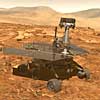
|
 |
Case of Sedna's missing moon reported solved
When the distant planetoid Sedna was discovered on the outer edges of our solar system, it posed a puzzle to scientists. Sedna appeared to be spinning very slowly. Astronomers hypothesized that this world possessed an unseen moon whose gravity was slowing Sedna's spin. Yet Hubble Space Telescope images showed no sign of a moon large enough to affect Sedna.
 FULL STORY FULL STORY
 |  |

|
 |
New Titan territory
Although the Huygens probe has now pierced the murky skies of Titan and landed on its surface, much of the moon remains for the Cassini spacecraft to explore. Titan continues to present exciting puzzles.
 FULL STORY FULL STORY
 |  |

|
 |
Swift measures distance to star explosion
The NASA-led Swift mission has measured the distance to two gamma-ray bursts -- back to back, from opposite parts of the sky -- and both were from over nine billion light years away, unleashed billions of years before the Sun and Earth formed.
 FULL STORY FULL STORY
 |  |

|
 |
Planets galore like Earth await discovery
How many planets like the Earth are there among the 130 or so known planetary systems beyond our own? How many of these "Earths" could be habitable?
 FULL STORY FULL STORY
 |  |
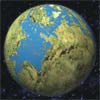
|
 |
Supernova origin clues found in dusty stellar wind
Scientists have detected a dusty wind emitted by a star that, at the end of its life, turned into a white dwarf and then exploded as a supernova. This is the first time that a wind from this type of supernova precursor has been observed and it is also the first time that associated dust has been detected.
 FULL STORY FULL STORY
 |  |

|
 |
'Super-starburst' galaxies hide active black holes
A team of European scientists has used Virtual Observatories to compare observations of distant "starburst" galaxies made at radio and X-ray wavelengths. This is the first study to combine the highest resolution and sensitivity radio and X-ray images which penetrate the dust hiding the centres of some of these distant galaxies.
 FULL STORY FULL STORY
 |  |

|
 |
LISA and the search for elusive gravity waves
For almost 100 years, scientists have been searching for direct evidence of the existence of gravity waves - faint ripples in the fabric of spacetime predicted in Albert Einstein's theory of General Relativity.
 FULL STORY FULL STORY
 |  |

|
 |
|
Earlier Headlines |

|
Photo gallery: Discovery's pre-launch moves
This collection of pictures follows space shuttle Discovery's progress in preparing for the return-to-flight launch at Kennedy Space Center as the payload bay doors are closed, rollout from its hangar, the lift upright inside the Vehicle Assembly Building and mating to the tank and booster rockets.
 ENTER GALLERY ENTER GALLERY
 |  |

|
 |
Astronaut's real-life story
International Space Station's Expedition 9 flight engineer Mike Fincke narrates home movies, shows photographs and re-lives his six-month mission aboard the orbiting complex in this highly entertaining presentation.
 |  |

|
 |

Video coverage for subscribers only:
 VIDEO:
EXPEDITION 9 HIGHLIGHTS DIAL-UP | BROADBAND VIDEO:
EXPEDITION 9 HIGHLIGHTS DIAL-UP | BROADBAND
 SUBSCRIBE NOW SUBSCRIBE NOW

|
Epimethean profile from Saturn-orbiting Cassini
Epimetheus is one of Saturn's "co-orbital moons" because it shares nearly the same orbit as Janus at a distance of approximately 94,000 miles from Saturn.
 FULL STORY FULL STORY
 |  |

|
 |
NASA finds soot may be changing the Arctic
NASA continues to explore the impact of black carbon or soot on the Earth's climate. NASA uses satellite data and computer models that recreate the climate. New findings show soot may be contributing to changes happening near the North Pole, such as accelerating melting of sea ice and snow and changing atmospheric temperatures.
 FULL STORY FULL STORY
 |  |

|
 |
Shape-shifting robot nanotech swarms on Mars
Like new and protective parents, engineers watched as the TETWalker robot successfully traveled across the floor at NASA's Goddard Space Flight Center. Robots of this type will eventually be miniaturized and joined together to form "autonomous nanotechnology swarms" that alter their shape to flow over rocky terrain, potentially supporting NASA's Vision for Space Exploration.
 FULL STORY FULL STORY
 |  |

|
 |
High tech invention awards
NASA has announced the 2004 Inventions of the Year Award winners. The Government Award went to researchers for their work in developing a thermal barrier and space shuttle solid rocket motor joint design. The Commercial Award went to the developer of a state-of-the-art high-temperature resin with numerous applications.
 FULL STORY FULL STORY
 |  |
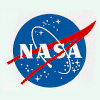
|
 |
Pandora at the edge
Pandora is seen in this dramatic view, orbiting just beyond the outer edge of Saturn's F ring. Several bright areas are visible within the F ring. In the main rings, the Keeler gap and the Encke gap, with a bright ringlet, are also visible.
 FULL STORY FULL STORY
 |  |

|
 |
Moon wears a scar
Saturn's moon Mimas shines in reflected ultraviolet light from the Sun in this Cassini image. Ultraviolet images of Saturn's moons often reveal the walls of their myriad craters in greater contrast than do images taken in visible light. This view, which shows the large impact crater Herschel, is no exception.
 FULL STORY FULL STORY
 |  |

|
 |
Hubble telescope spies cosmic dust bunnies
Like dust bunnies that lurk in corners and under beds, surprisingly complex loops and blobs of cosmic dust lie hidden in the giant elliptical galaxy NGC 1316. This image made from data obtained with the NASA Hubble Space Telescope reveals the dust lanes and star clusters of this giant galaxy that give evidence that it was formed from a past merger of two gas-rich galaxies.
 FULL STORY FULL STORY
 |  |

|
 |
New image of Earth, seen through gamma-ray eyes
A NASA-funded scientist has produced a new type of picture of the Earth from space, which complements the familiar image of our "blue marble". This new picture is the first detailed image of our planet radiating gamma rays, a type of light that is millions to billions of times more energetic than visible light.
 FULL STORY FULL STORY
 |  |

|
 |
Cassini shows you can see for miles and miles
This sweeping view from Cassini gives a sense of the awesome scale of the planet's disk-like ring system, which stretches vastly into the distance. The shepherd moon Prometheus maintains a lonely sojourn with the thin, outer F ring.
 FULL STORY FULL STORY
 |  |

|
 |
Missing link from galaxy collisions to star birth
Data from ISO, the infrared observatory of the European Space Agency, have provided the first direct evidence that shock waves generated by galaxy collisions excite the gas from which new stars will form. The result also provides important clues on how the birth of the first stars was triggered and speeded up in the early Universe.
 FULL STORY FULL STORY
 |  |

|
 |
Russian communications satellite put into orbit
A Russian Proton rocket successfully launched a next-generation domestic communications satellite Tuesday night that will be able to reach over a billion people across large parts of Asia.
 FULL STORY FULL STORY
 |  |

|
 |
Shuttle Discovery leaves hangar on road to launch
Space shuttle Discovery emerged from its space-age garage at the Kennedy Space Center at 2 a.m. EST (0700 GMT) Tuesday for the quarter-mile move to the 52-story Vehicle Assembly Building where the ship will be mated with an external fuel tank and twin solid rocket boosters over the next few days. Discovery will return the shuttle program to flight with its launch now targeted for mid-May.
 MISSION STATUS CENTER - updates! MISSION STATUS CENTER - updates!
 |  |

|
 |

Video coverage for subscribers only:
 VIDEO:
WALK ALONGSIDE DISCOVERY DURING TRANSFER TO VAB QT VIDEO:
WALK ALONGSIDE DISCOVERY DURING TRANSFER TO VAB QT
 VIDEO:
TIME-LAPSE MOVIE OF DISCOVERY LEAVING HANGAR QT VIDEO:
TIME-LAPSE MOVIE OF DISCOVERY LEAVING HANGAR QT
 VIDEO:
SPED UP VERSION OF HANGAR DEPARTURE MOVIE QT VIDEO:
SPED UP VERSION OF HANGAR DEPARTURE MOVIE QT
 VIDEO:
TIME-LAPSE MOVIE OF SHUTTLE ROLLING INTO VAB QT VIDEO:
TIME-LAPSE MOVIE OF SHUTTLE ROLLING INTO VAB QT
 VIDEO:
SPED UP VERSION OF VAB ARRIVAL MOVIE QT VIDEO:
SPED UP VERSION OF VAB ARRIVAL MOVIE QT
 VIDEO:
NASA'S STEVE POULOS TALKS WITH REPORTERS QT VIDEO:
NASA'S STEVE POULOS TALKS WITH REPORTERS QT
 SUBSCRIBE NOW SUBSCRIBE NOW

|
Dying stars may bring life to frozen worlds
Dying stars may warm previously frozen worlds around them to the point where liquid water temperature exists long enough for life to form, according to a new analysis of the evolution of habitable zones around stars by an international team of astronomers.
 FULL STORY FULL STORY
 |  |

|
 |
Station gyro experiences unusual vibration
About five minutes after space station commander Leroy Chiao and Salizhan Sharipov wrapped up a successful early morning spacewalk Monday, one of the station's two operational control moment gyroscopes, used to stabilized the complex and change its orientation, experienced an unusually high vibration.
 FULL STORY FULL STORY
 |  |

|
 |
Space station crew steps outside for EVA
As their half-year mission aboard the International Space Station winds down, the two-man Expedition 10 crew took a spacewalk Monday to complete external outfitting of gear that will guide European cargo ships to the outpost and to toss a tiny nanosatellite overboard for remote engineering experiments. The EVA began at 1:25 a.m. EST (0625 GMT) and lasted four hours and 30 minutes, concluding an hour ahead of schedule.
 POST-EVA STATUS REPORT POST-EVA STATUS REPORT
 PREVIEW STORY PREVIEW STORY
 |  |
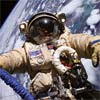
|
 |

Video coverage for subscribers only:
 VIDEO:
RUSSIAN NANOSATELLITE HAND-LAUNCHED DURING EVA QT VIDEO:
RUSSIAN NANOSATELLITE HAND-LAUNCHED DURING EVA QT
 VIDEO:
COMPILATION OF SPACEWALK VIDEO HIGHLIGHTS QT VIDEO:
COMPILATION OF SPACEWALK VIDEO HIGHLIGHTS QT
 VIDEO:
DETAILED SPACEWALK PREVIEW DIAL-UP | BROADBAND VIDEO:
DETAILED SPACEWALK PREVIEW DIAL-UP | BROADBAND
 VIDEO:
MEET THE EXPEDITION 10 CREWMATES QT VIDEO:
MEET THE EXPEDITION 10 CREWMATES QT
 SUBSCRIBE NOW SUBSCRIBE NOW

|
First solar sail continues methodical launch checklist
The world's revolutionary first solar sail - named Cosmos 1 - is creeping closer to flight as tests are checked off one-by-one in advance of its launch aboard a converted ballistic missile in the next one to two months.
 FULL STORY FULL STORY
 |  |
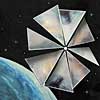
|
 |
Janus rides the rings
Cassini was nearly in the plane of Saturn's rings when it took this image of Janus. The nearly edge-on rings appear almost ribbon-like in this view, and some surface detail is visible on the small moon.
 FULL STORY FULL STORY
 |  |

|
 |
Deep Impact's comet-watching telescope blurred
The largest telescope ever launched into deep space is out of focus, NASA acknowledged Friday, but scientists say it still should collect the sharpest pictures of a comet's icy heart during a violent encounter July 4.
 FULL STORY FULL STORY
 |  |

|
 |

Video coverage for subscribers only:
 VIDEO:
DEEP IMPACT LAUNCHED ATOP DELTA 2 ROCKET QT VIDEO:
DEEP IMPACT LAUNCHED ATOP DELTA 2 ROCKET QT
 VIDEO:
LAUNCH AS SEEN FROM THE CAPE PRESS SITE QT VIDEO:
LAUNCH AS SEEN FROM THE CAPE PRESS SITE QT
 VIDEO:
COCOA BEACH TRACKING CAMERA VIDEO OF LAUNCH QT VIDEO:
COCOA BEACH TRACKING CAMERA VIDEO OF LAUNCH QT
 VIDEO:
OVERVIEW OF NASA'S DEEP IMPACT MISSION QT VIDEO:
OVERVIEW OF NASA'S DEEP IMPACT MISSION QT
 VIDEO:
LEAD RESEARCHER PREVIEWS DEEP IMPACT SCIENCE QT VIDEO:
LEAD RESEARCHER PREVIEWS DEEP IMPACT SCIENCE QT
 VIDEO:
SCIENCE BRIEFING ON EVE OF LAUNCH DIAL-UP | BROADBAND VIDEO:
SCIENCE BRIEFING ON EVE OF LAUNCH DIAL-UP | BROADBAND
 SUBSCRIBE NOW SUBSCRIBE NOW

|
Sliced-up craters on Saturn's moon Enceladus
During its very close flyby of Enceladus this month, Cassini took high resolution images of the icy moon that are helping scientists interpret the complex topography of this intriguing little world. This scene is an icy landscape that has been scored by tectonic forces.
 FULL STORY FULL STORY
 |  |

|
 |
Young and exotic stellar zoo
Super star clusters are groups of hundreds of thousands of very young stars packed into an unbelievably small volume. They represent the most extreme environments in which stars and planets can form.
 FULL STORY FULL STORY
 |  |

|
 |
X-rays signal presence of elusive black hole
Peculiar outbursts of X-rays coming from a black hole have provided evidence that it has a mass of about 10,000 Suns, which would place it in a possible new class of black holes. The timing and regularity of these outbursts, observed with NASA's Chandra X-ray Observatory, make the object one of the best candidates yet for a so-called intermediate-mass black hole.
 FULL STORY FULL STORY
 |  |

|
 |
Far-off fractures on Dione
Wispy streaks curl over the horizon on Saturn's moon Dione, caught here in a distant view from Cassini. The streaks were first revealed by NASA's Voyager spacecraft and subsequently were shown by Cassini to be an immense system of linear fractures in the moon's surface.
 FULL STORY FULL STORY
 |  |

|
 |
OTHER HEADLINES Additional stories today
|
 |
NASA announces first Centennial Challenges' prizes -- NASA has announced prizes totaling $400,000 for four prize competitions, the first under the agency's Centennial Challenges program, which promotes technical innovation through a novel program of prize competitions. It is designed to tap the nation's ingenuity to make revolutionary advances to support the Vision for Space Exploration and NASA goals.

Iridium constellation passes milestone for longevity -- Iridium Satellite says that its constellation of low-earth-orbit communication satellites has achieved a world record of more than 500 satellite-years of in-orbit performance. Iridium's constellation consists of 66 active satellites.
|
 |
NASA works to define what hits shuttles can withstand
NASA finally has test data indicating any foam debris falling from the space shuttle's redesigned external fuel tank almost certainly will be below the threshold expected to cause "entry critical" damage to wing leading edge panels, officials said Tuesday.
 FULL STORY FULL STORY
 STORE: OFFICIAL MISSION PATCH STORE: OFFICIAL MISSION PATCH
 |  |

|
 |
First detection of light from extrasolar planets
Two teams of astronomers announced at a press conference Tuesday that they have directly detected light from two known planets orbiting distant stars. This discovery opens a new frontier in the study of extrasolar planets. Researchers now can directly measure and compare such planetary characteristics as color, reflectivity, and temperature.
 CORNELL STORY CORNELL STORY
 HARVARD-SMITHSONIAN STORY HARVARD-SMITHSONIAN STORY
 |  |

|
 |

Video coverage for subscribers only:
 VIDEO:
WATCH TUESDAY'S NEWS CONFERENCE DIAL-UP | BROADBAND VIDEO:
WATCH TUESDAY'S NEWS CONFERENCE DIAL-UP | BROADBAND
 AUDIO:
LISTEN TO ASTRONOMERS ANNOUNCE DISCOVERY FOR IPOD AUDIO:
LISTEN TO ASTRONOMERS ANNOUNCE DISCOVERY FOR IPOD
 SUBSCRIBE NOW SUBSCRIBE NOW

|
Robotic astrobiology trip yields major findings
A group of scientists have identified habitats and microbial life using a robotic rover in Chile's arid Atacama desert, one of the harshest environments on Earth, and that their findings may bode well for future missions to Mars.
 FULL STORY FULL STORY
 |  |

|
 |
First West Coast Atlas 5 rocket pointed skyward
From the brink of nothingness to a hopeful future, Lockheed Martin's Atlas rocket program at Vandenberg Air Force Base in California has experienced the ultimate swing of emotions over the past two years. Now, a new rocket stands on the launch pad.
 FULL STORY FULL STORY
 |  |

|
 |
Serenity of Saturn
As if drawn by an artist, this sublime scene speaks of the powerful beauty in the outer solar system: the domain of giant planets encircled by rings and orbited by small cratered moons of ice.
 FULL STORY FULL STORY
 |  |

|
 |
Hyperion hoopla
As it loops around Saturn, Cassini periodically gets a good view of Saturn's moon Hyperion. Hyperion chaotically tumbles around in its orbit and is perhaps the largest irregularly-shaped moon in the solar system.
 FULL STORY FULL STORY
 |  |

|
 |
Galaxies show a mature Universe in childhood
Scientists have discovered the most distant massive structure yet detected in the Universe, a fully formed galaxy cluster containing hundreds, if not thousands, of galaxies. The discovery is evidence that the Universe's elegant hierarchal structure of stars, galaxies and clusters formed quickly after the big bang, far earlier than most astronomers thought possible just a few years ago.
 FULL STORY FULL STORY
 |  |

|
 |
Volunteer network provides ringside seat to Saturn
Experiencing Saturn through a telescope for the first time is a feast for the eyes. NASA's Cassini mission to Saturn is helping people savor the view by coordinating a network of people and telescopes around the globe to help others see the ringed giant.
 FULL STORY FULL STORY
 |  |
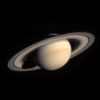
|
 |
Enceladus moon portrait backdropped by Saturn
During its very close flyby on March 9, the Cassini spacecraft captured this view of Saturn's moon Enceladus. The atmosphere of Saturn forms the background of this scene.
 FULL STORY FULL STORY
 |  |

|
 |
Old and new again on Saturn's moon Enceladus
This Cassini mosaic of Saturn's moon Enceladus captures in a single view, much of the frigid moon's diverse geology. Cratered terrain dominates most of the scene. The relatively dense accumulation of impact craters implies that this terrain is among the oldest on the moon's surface. The entire area is transected by a complex web of fractures and faults.
 FULL STORY FULL STORY
 |  |

|
 |
Revealing intriguing details of an icy world
To human eyes, Enceladus appears almost completely white, but false color reveals interesting details. This view is a composite of images has been processed to accentuate subtle color differences. The uppermost surface of these terrains appears uniformly grey in this picture, suggesting that they are covered with materials of homogeneous composition and grain size. However, the walls of many of the fractures appear to be somewhat bluer than typical surface materials.
 FULL STORY FULL STORY
 |  |

|
 |
Quest to understand matter right after the big bang
Scientists trying to recreate conditions that existed just a few millionths of a second after the big bang that started the universe have run into a mysterious problem - some of the reactions they are getting don't mesh with what they thought they were supposed to see.
 FULL STORY FULL STORY
 |  |

|
 |
NASA uses imaging radar to detect coastal pollution
A NASA-funded study of marine pollution in Southern California concluded space-based synthetic aperture radar can be a vital observational tool for assessing and monitoring ocean hazards in urbanized coastal regions.
 FULL STORY FULL STORY
 |  |

|
 |
Station gyro problem no threat to shuttle mission
The shutdown of an orientation control gyroscope aboard the international space station will not impact the planned launch of the shuttle Discovery in May, officials said Thursday, even though only two of the lab's four gyros will be operating when the orbiter arrives.
 FULL STORY FULL STORY
 |  |

|
 |
Photo gallery: Atlas 5 rocket launch for Inmarsat
This collection of photographs taken from a variety of locales captures the successful launch of Lockheed Martin's fifth Atlas 5 rocket. Last week's mission from Cape Canaveral placed the Inmarsat 4-F1 mobile communications satellite into Earth orbit.
 ENTER PHOTO GALLERY ENTER PHOTO GALLERY
 EARLIER PRE-LAUNCH GALLERY EARLIER PRE-LAUNCH GALLERY
 |  |

|
 |

Video coverage for subscribers only:
 VIDEO:
SPACEFLIGHT NOW LAUNCH PAD CAMERA QT VIDEO:
SPACEFLIGHT NOW LAUNCH PAD CAMERA QT
 SUBSCRIBE NOW SUBSCRIBE NOW

|
Dark energy evidence in local galactic neighborhood
Astrophysicists in recent years have found evidence for a force they call dark energy in observations from the farthest reaches of the universe, billions of light years away. Now researchers have used data from powerful computer models, supported by the Hubble Space Telescope, to find evidence of dark energy right in our own cosmic neighborhood.
 FULL STORY FULL STORY
 |  |

|
 |
Delta 4-Heavy investigation identifies rocket's problem
The inaugural Boeing Delta 4-Heavy rocket suffered premature engine shutdowns during its December test launch because of bubbles in the liquid oxygen plumbing, investigators have concluded, and now corrective measures are being devised to prevent a repeat problem during the next launch in October.
 FULL STORY FULL STORY
 |  |

|
 |

Video coverage for subscribers only:
 VIDEO:
SPACEFLIGHT NOW LAUNCH PAD CAMERA 1 QT VIDEO:
SPACEFLIGHT NOW LAUNCH PAD CAMERA 1 QT
 VIDEO:
SPACEFLIGHT NOW LAUNCH PAD CAMERA 2 QT VIDEO:
SPACEFLIGHT NOW LAUNCH PAD CAMERA 2 QT

 VIDEO:
FROM LIFTOFF TO BOOSTER SEPARATION QT VIDEO:
FROM LIFTOFF TO BOOSTER SEPARATION QT
 VIDEO:
THE DELTA 4-HEAVY LAUNCH (SHORT VERSION) QT VIDEO:
THE DELTA 4-HEAVY LAUNCH (SHORT VERSION) QT
 VIDEO:
ONBOARD CAMERA RECORDS LAUNCH QT VIDEO:
ONBOARD CAMERA RECORDS LAUNCH QT
 VIDEO:
ONBOARD CAMERA SEES BOOSTER SEPARATION QT VIDEO:
ONBOARD CAMERA SEES BOOSTER SEPARATION QT
 VIDEO:
ONBOARD CAMERA CAPTURES FAIRING JETTISON QT VIDEO:
ONBOARD CAMERA CAPTURES FAIRING JETTISON QT
 SUBSCRIBE NOW SUBSCRIBE NOW

|
Cassini finds atmosphere on Saturn's moon Enceladus
The Cassini spacecraft's two close flybys of Saturn's icy moon Enceladus have revealed that the moon has a significant atmosphere. Scientists, using Cassini's magnetometer instrument for their studies, say the source may be volcanism, geysers, or gases escaping from the surface or the interior.
 FULL STORY FULL STORY
 |  |

|
 |
Cracked face of Enceladus
The finest details on the surface of Saturn's moon Enceladus are revealed in this 100-foot per-pixel, enhanced-color image taken during Cassini's closest-ever encounter with Enceladus on March 9.
 FULL STORY FULL STORY
 |  |

|
 |
Enceladus in color
This false-color, close-up look at Saturn's moon Enceladus yields new insight into the different processes that have shaped the moon's icy surface. Extending through the center of this image is a system of rifts 2 miles wide and lanes of grooved terrain 12 miles wide, which separate two distinct geological provinces.
 FULL STORY FULL STORY
 |  |

|
 |
Space station loses gyro
A circuit breaker aboard the international space station popped open early Wednesday, interrupting power to one of the three operational gyroscopes used to maintain the lab's orientation in space. NASA officials said the failure would have no immediate impact and that the space station's orientation could be maintained with just two gyros while engineers study the problem.
 FULL STORY FULL STORY
 |  |

|
 |
Mars rover Opportunity hit by instrument problem
NASA has suspended use of one of the mineral-identifying tools on the Opportunity Mars rover while experts troubleshoot a problem with getting data from the instrument.
 FULL STORY FULL STORY
 |  |
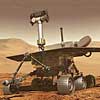
|
 |
Steering system work delays Minotaur launch
Engineers have elected to replace a vital control unit inside the steering system of an Orbital Sciences Minotaur rocket, delaying Friday's launch of the vehicle and its Air Force spacecraft cargo by several weeks.
 FULL STORY FULL STORY
 |  |

|
 |
Second shuttle fuel tank arrives at the Cape
NASA's second redesigned space shuttle external tank, designated for use on Atlantis mission STS-121 in July, is now in place at Kennedy Space Center, Florida.
 FULL STORY FULL STORY
 |  |

|
 |
Mars rover watches dust devils spin across landscape
NASA's Mars Exploration Rover Spirit, which remains in good health after 14 months on the Red Planet, has witnessed a pair of miniature tornado-like dust devils for the first time as they swirled across Gusev Crater.
 FULL STORY FULL STORY
 |  |

|
 |
Little moons of Saturn
The irregularly-shaped moon Janus and the small ring moon Atlas had just emerged from the darkness of Saturn's shadow when Cassini caught this view of the two moons. Saturn's bright A ring is largely overexposed in this view, but several other ring details are nicely visible.
 FULL STORY FULL STORY
 |  |

|
 |
Jupiter's high-voltage auroras probed by Chandra
Scientists have obtained new insight into the unique power source for many of Jupiter's auroras, the most spectacular and active auroras in the Solar System. Extended monitoring of the giant planet with NASA's Chandra X-ray Observatory detected the presence of highly charged particles crashing into the atmosphere above its poles.
 FULL STORY FULL STORY
 |  |

|
 |
Astronomers measure slowest motion across sky
Astronomers report that they have measured the slowest ever motion of a galaxy across the plane of the sky. This distant whirlpool of stars appears to creep along despite its actual speed through space because it is located so far from the Earth. Measuring this galaxy's glacial pace of only 30 micro-arcseconds per year stretched current radio astronomy technology to its limit.
 FULL STORY FULL STORY
 |  |

|
 |
Atlas rocket family extends launch success record
Riding the most powerful Atlas rocket in history, the world's heaviest commercial communications satellite is circling the Earth following Friday's fast and fiery blastoff from Cape Canaveral.
 FULL STORY FULL STORY
 |  |

|
 |

Video coverage for subscribers only:
 VIDEO:
ATLAS 5 ROCKET BLASTS OFF WITH INMARSAT 4-F1 QT VIDEO:
ATLAS 5 ROCKET BLASTS OFF WITH INMARSAT 4-F1 QT
 VIDEO:
WATCH EXTENDED LENGTH LAUNCH MOVIE QT VIDEO:
WATCH EXTENDED LENGTH LAUNCH MOVIE QT
 VIDEO:
ONBOARD VIEW OF SOLID ROCKET BOOSTER SEPARATION QT VIDEO:
ONBOARD VIEW OF SOLID ROCKET BOOSTER SEPARATION QT
 VIDEO:
LAUNCH AS SEEN FROM THE PRESS SITE QT VIDEO:
LAUNCH AS SEEN FROM THE PRESS SITE QT

 VIDEO:
NARRATED ANIMATION PREVIEW OF THIS LAUNCH QT VIDEO:
NARRATED ANIMATION PREVIEW OF THIS LAUNCH QT
 VIDEO:
OVERVIEW OF INMARSAT AND ITS NEWEST SATELLITE QT VIDEO:
OVERVIEW OF INMARSAT AND ITS NEWEST SATELLITE QT
 VIDEO:
TECHNICAL BRIEFING ON THE INMARSAT 4-F1 SPACECRAFT QT VIDEO:
TECHNICAL BRIEFING ON THE INMARSAT 4-F1 SPACECRAFT QT
 SUBSCRIBE NOW SUBSCRIBE NOW

|
Mystery of Meteor Crater reported solved
The iron meteorite that blasted out Meteor Crater almost 50,000 years ago was traveling much slower than has been assumed, according to scientists using sophisticated mathematical models in analyzing how the meteorite would have broken up and decelerated as it plummeted down through the atmosphere.
 FULL STORY FULL STORY
 |  |

|
 |
Scientists say hassled galaxy 'thriving on chaos'
Powerful but unknown forces are at work in a small companion galaxy of the Milky Way, astronomers say in the latest issue of the journal Science. Something is keeping the structure and magnetic field of this galaxy (the Large Magellanic Cloud) strong and ordered, even while the Milky Way's gravity works to tear them apart.
 FULL STORY FULL STORY
 |  |

|
 |
A tale of two El Ninos
"It was the best of times, it was the worst of times..." The same event can have dramatically different outcomes. For some, an El Nino means a welcome respite from bitter winter weather. For others, it can bring lashing rains and devastating floods.
 FULL STORY FULL STORY
 |  |

|
 |
Early universe looks like 'vegetable soup'
What did the universe look like when it was only 2 to 3 billion years old? Astronomers used to think it was a pretty simple place containing relatively small, young star-forming galaxies. Researchers now are realizing that the truth is not that simple. Even the early universe was a wildly complex place.
 FULL STORY FULL STORY
 |  |

|
 |
Bush nominates Griffin as NASA Administrator
The White House says President Bush intends to nominate Michael D. Griffin to be the new NASA Administrator. Dr. Griffin currently serves as Space Department Head at Johns Hopkins University Applied Physics Laboratory. He replaces Sean O'Keefe who left the space agency last month.
 |  |

|
 |
Atlas 5 rocket lifts off
The world's heaviest commercial communications satellite successfully launched from Cape Canaveral atop a tailor-built Lockheed Martin Atlas 5 rocket at 4:42 p.m. EST Friday.
 MISSION STATUS CENTER MISSION STATUS CENTER
 |  |

|
 |
Photo gallery: rocket rollout
Riding atop a mobile launching platform, the Atlas 5 rocket is rolled from its assembly building to the launch pad at Cape Canaveral's Complex 41 Thursday morning just hours before its planned liftoff time carrying the Inmarsat 4-F1 communications satellite payload. Although the launch attempt was later scrubbed, the rocket remained on the pad during the 24-hour postponement.
 ENTER PHOTO GALLERY ENTER PHOTO GALLERY
 |  |

|
 |
Active, Earth-like world revealed by Cassini
Saturn's hazy largest moon, Titan - a body long held to be a frozen analog of early Earth - has a surface shaped largely by an Earth-like interplay of tectonics, erosion by fluids, winds, and perhaps volcanism. So reports the Cassini imaging team in the latest issue of Nature, in their first published presentation of findings from images of Titan gathered since last July.
 FULL STORY FULL STORY
 |  |

|
 |
Cassini discovers a windy, wavy Titan atmosphere
The dynamic atmosphere of Saturn's haze-enshrouded moon Titan is revealed in the first Cassini Imaging Team report on Titan. Scientists, analyzing images of Titan designed to allow views of the surface and lower atmosphere, have discovered that the winds on Titan blow a lot faster than the moon rotates. In contrast, the jet stream of Earth blows a lot slower than the surface of our planet moves.
 FULL STORY FULL STORY
 |  |

|
 |
Hubble weighs in on the heaviest stars in the galaxy
Astronomers have taken an important step toward establishing an upper limit to the masses of stars. Using NASA's Hubble Space Telescope, they made the first direct measurement within our Milky Way Galaxy, and concluded stars cannot get any larger than about 150 times the mass of our sun.
 FULL STORY FULL STORY
 |  |

|
 |
Guarding against flaws in shuttle's tank foam
The engineers who built the massive external fuel tank that will power the shuttle Discovery into orbit this spring used sophisticated X-ray detectors developed by University of Florida researchers to reduce the chance of a defect in the foam insulation covering the tank. The detectors, first invented as a new technology to find land mines, can identify tiny gaps, or air-filled voids, in the insulating foam without causing any damage.
 FULL STORY FULL STORY
 |  |

|
 |
Superglue of planet formation: Sticky ice
How dust specks in the early solar systems came together to become planets has vexed astronomers for years. Scientists report in the current issue of Astrophysical Journal a cool answer to the planet-formation riddle: Micron-wide dust particles encrusted with molecularly gluey ice enabled planets to bulk up like dirty snowballs quickly enough to overcome the scattering force of solar winds.
 FULL STORY FULL STORY
 |  |

|
 |
NASA finds lightning clears safe zone in radiation belt
Lightning in clouds, only a few miles above the ground, clears a safe zone in the radiation belts thousands of miles above the Earth, according to NASA-funded researchers. The unexpected result resolves a forty-year-old debate as to how the safe zone is formed, and it illuminates how the region is cleared after it is filled with radiation during magnetic storms.
 FULL STORY FULL STORY
 |  |

|
 |
MESSENGER probe deploys magnetometer boom
The Mercury-bound MESSENGER spacecraft is now cruising with its sunshade facing the Sun and its 12-foot magnetometer boom extended, after a pair of long-planned and successful operations Tuesday.
 FULL STORY FULL STORY
 |  |
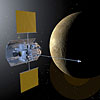
|
 |
Newly seen force may help gravity in star formation
Scientists have pierced through a dusty stellar nursery to capture the earliest and most detailed view of a collapsing gas cloud turning into a star, analogous to a baby's first ultrasound.
 FULL STORY FULL STORY
 |  |

|
 |
Moonbeams shine on Einstein, Galileo, Newton
Thirty-five years after Moon-walking astronauts placed special reflectors on the lunar surface, scientists have used these devices to test Albert Einstein's general theory of relativity to unprecedented accuracy. The findings, which also confirm theories from Galileo Galilei and Isaac Newton, may help to explain physical laws of the universe and benefit future space missions.
 FULL STORY FULL STORY
 |  |
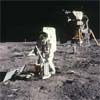
|
 |
NASA study suggests giant space clouds iced Earth
Eons ago, giant clouds in space may have led to global extinctions, according to two recent technical papers supported by NASA's Astrobiology Institute. One paper outlines a rare scenario in which Earth iced over during snowball glaciations, after the solar system passed through dense space clouds. In a more likely scenario, less dense giant molecular clouds may have enabled charged particles to enter Earth's atmosphere, leading to destruction of much of the planet's protective ozone layer.
 FULL STORY FULL STORY
 |  |

|
 |
Chinese planning for second manned spaceflight
Now well over a year since China's first manned spaceflight, more information is slowly being released about their next foray into space. Dubbed Shenzhou 6, the flight is currently scheduled for launch this fall.
 FULL STORY FULL STORY
 |  |
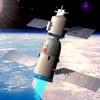
|
 |
European probe slings past Earth on long trip to comet
The one-year old Rosetta comet chaser made a return visit to Earth Friday, flying by the planet to receive a boost to begin the long process of eventually sending the spacecraft on a trajectory to intercept the comet Churyumov-Gerasimenko in 2014.
 FULL STORY FULL STORY
 |  |

|
 |
Second redesigned shuttle external tank to ship
NASA will ship its second redesigned space shuttle external tank Saturday from the Michoud Assembly Facility, near New Orleans, marking the first step toward final preparations for the launch of Atlantis on mission STS-121, possibly this summer.
 FULL STORY FULL STORY
 |  |

|
 |
Shuttle mission simulation tests post-Columbia team
The shuttle Discovery docked with the international space station Friday in a dramatic mission simulation that included presumed foam debris impacts to the orbiter's right wing leading edge and an aft rocket pod during the make-believe climb to space.
 FULL STORY FULL STORY
 |  |

|
 |
Air Force lifts Boeing's rocket launch suspension
Air Force officials removed the suspension of three Boeing Co. units associated with its rocket business. The 20-month suspension, which has been the longest for a major defense contractor, was triggered by wrongdoing in the EELV program.
 READ ANNOUNCEMENT READ ANNOUNCEMENT
 DOWNLOAD BOEING/AIR FORCE AGREEMENT DOWNLOAD BOEING/AIR FORCE AGREEMENT
 |  |

|
 |
Hubble sees impending destruction of galaxy
What happens when a galaxy falls in with the wrong crowd? The irregular galaxy NGC 1427A is a spectacular example of the resulting stellar rumble. Under the gravitational grasp of a large gang of galaxies, called the Fornax cluster, the small bluish galaxy is plunging headlong into the group at nearly 400 miles per second.
 FULL STORY FULL STORY
 |  |

|
 |
Jupiter's formation linked to primitive meteorites
The process that formed the giant planet Jupiter may also have spawned some of the tiniest and oldest members of our solar system -- millimeter-sized spheres called chondrules, the major part of the most primitive meteorites. As witnesses to the early history of the solar system, chondrules may provide important clues to how the planets formed.
 FULL STORY FULL STORY
 |  |

|
 |
Discovery points to new class of objects
Astronomers at Sweet Briar College and the Naval Research Laboratory have detected a powerful new bursting radio source whose unique properties suggest the discovery of a new class of astronomical objects. The researchers have monitored the center of the Milky Way Galaxy for several years and reveal their findings in the journal Nature.
 FULL STORY FULL STORY
 |  |

|
 |
Mars rovers break driving records, find salty soil
On three consecutive days, NASA's Mars Exploration Rover Opportunity accomplished unprecedented feats of martian motion, covering more total ground in that period than either Opportunity or its twin, Spirit, did in their first 70 days on Mars.
 FULL STORY FULL STORY
 |  |

|
 |
International Space Station receives cargo vessel
A Russian cargo-delivery freighter safely docked to the International Space Station Wednesday, ferrying more than two tons of supplies and equipment for the outpost and its resident crew.
 FULL STORY FULL STORY
 |  |

|
 |

Video coverage for subscribers only:
 VIDEO:
CARGO SHIP AND STATION RENDEZVOUS IN SPACE QT VIDEO:
CARGO SHIP AND STATION RENDEZVOUS IN SPACE QT
 VIDEO:
THE PROGRESS VEHICLE FLIES AROUND THE STATION QT VIDEO:
THE PROGRESS VEHICLE FLIES AROUND THE STATION QT
 VIDEO:
DOCKING AS SEEN FROM CAMERA ON THE PROGRESS QT VIDEO:
DOCKING AS SEEN FROM CAMERA ON THE PROGRESS QT
 VIDEO:
10-MINUTE MOVIE OF APPROACHING AND DOCKING QT VIDEO:
10-MINUTE MOVIE OF APPROACHING AND DOCKING QT
 SUBSCRIBE NOW SUBSCRIBE NOW

|
Europe's navigation system still doesn't have leader
��After a series of negotiations and reviews, European officials announced they are still several months away from selecting a contractor to operate the $4.5 billion Galileo satellite navigation system due to begin launches within a year.
 FULL STORY FULL STORY
 |  |

|
 |
Satellite watchers worried about Air Force restrictions
On Sept. 12, 2001, the day after the terrorist attacks on the World Trade Center and the Pentagon, someone in Afghanistan using the name "newboy1" registered at a NASA website that publicly distributes Air Force satellite tracking data.
 FULL STORY FULL STORY
 |  |

|
 |
Spitzer exposes dusty galactic hideouts
How do you hide something as big and bright as a galaxy? You smother it in cosmic dust. NASA's Spitzer Space Telescope saw through the cosmic dust to uncover a hidden population of monstrously bright galaxies approximately 11 billion light-years away.
 FULL STORY FULL STORY
 |  |

|
 |
Shuttle external fuel tank mated to boosters
NASA is marking a major step in assembling the space shuttle for its Return to Flight mission. Monday, workers successfully "mated," or attached, the redesigned external tank and twin solid rocket boosters. The stack will help launch shuttle Discovery on May 15.
 FULL STORY FULL STORY
 |  |

|
 |

Video coverage for subscribers only:
 VIDEO:
EXTERNAL TANK MATED TO THE SOLID ROCKET BOOSTERS QT VIDEO:
EXTERNAL TANK MATED TO THE SOLID ROCKET BOOSTERS QT
 SUBSCRIBE NOW SUBSCRIBE NOW

|
Ozone loss tied to Arctic winds, solar storms
Nitrogen oxide and nitrogen dioxide gases in the upper stratosphere climbed to their highest levels in at least two decades in spring 2004, scientists report. The increases led to ozone reductions of up to 60 percent. Two natural processes were responsible, the scientists say.
 FULL STORY FULL STORY
 |  |

|
 |
Sea Launch rocket puts radio satellite into space
With its popularity growing and new subscribers steadily signing up, XM Satellite Radio successfully deployed its third broadcasting spacecraft Monday night using a sea-launched rocket from a platform floating in equatorial waters of the Pacific.
 FULL STORY FULL STORY
 MISSION STATUS CENTER MISSION STATUS CENTER
 |  |

|
 |
Resupply ship rockets to International Space Station
A cargo vessel stuffed with much-needed repair kits, food, water and rocket fuel for the International Space Station launched from Baikonur Cosmodrome in Kazakhstan Monday, beginning a two-day trek to the high-flying laboratory.
 FULL STORY FULL STORY
 |  |

|
 |
'Great Earth Observatory' marks 5 years of work
Five years ago this month, NASA's Terra satellite began measuring Earth's vital signs with accuracy, precision, and resolution the world had never seen before. This great Earth observing satellite was launched to look at many aspects of Earth's changing climate.
 FULL STORY FULL STORY
 |  |
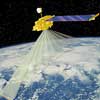
|
 |
Cassini spacecraft explores Saturn's radiation belts
Using an innovative camera on NASA's Cassini spacecraft, scientists have captured images of a radiation belt inside the rings of Saturn and have the clearest picture yet of the planet's giant magnetosphere, according to a mid-year report of the spacecraft published in the journal Science.
 FULL STORY FULL STORY
 |  |

|
 |
Cassini captures greatest Saturn portrait yet
While cruising around Saturn, Cassini captured a series of images that have been composed into the largest, most detailed, global natural color view of Saturn and its rings ever made.
 FULL STORY FULL STORY
 |  |

|
 |
Beleaguered H-2A rocket roars into orbit
�The Japanese H-2A rocket returned to space Saturday with its long-awaited mission to launch a multi-purpose satellite to serve pilots and weather forecasters throughout Asia and the Pacific. The crucial resumption of launches came 15 months after a painful failure that added to the woes that country's space program encountered in recent years.
 MISSION STATUS CENTER MISSION STATUS CENTER
 |  |

|
 |
Treasures found among Saturn's rings, moons
The high porosity of Saturn's innermost small moons, tenuous ringlets discovered in some of the gaps in its rings, the variation in ring particle composition across the rings, and new ring structures which indicate more clearly than ever the transient clumping and aggregation of particles as they orbit Saturn are among the discoveries being reported by the Cassini Imaging Science team.
 FULL STORY FULL STORY
 |  |

|
 |
Features on Saturn's moon Phoebe given names
Twenty-four of the largest craters on Phoebe, the small, retrograde outer moon of Saturn have been assigned names by the International Astronomical Union.
 FULL STORY FULL STORY
 |  |

|
 |
Saturn's uniquely complex magnetosphere
Scientists have marveled at Saturn's giant magnetosphere and the plasma -- a complex magnetized fluid of hot charged particles -- confined within it. Using new data from the Cassini mission, scientists are beginning to tease out the melange of ingredients and processes that contribute to the ringed planet's surprisingly complicated magnetosphere.
 FULL STORY FULL STORY
 |  |
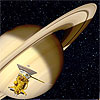
|
 |
Europe's Mars Express sees signs of a 'frozen sea'
The discovery of what could be a frozen sea close to the Martian equator, protected from disappearing by a thin layer of volcanic ash, was reported this week at the first Mars Express Science Conference in Noordwijk, the Netherlands.
 FULL STORY FULL STORY
 |  |

|
 |
Cassini locks on target
Cassini's ability to remain precisely and steadily pointed at targets, such as Saturn's moon Mimas seen here yields sharp images despite the relatively high speed at which the spacecraft moves.
 FULL STORY FULL STORY
 |  |

|
 |
OTHER HEADLINES Additional stories today
|
 |
Loral to build Galaxy 18 -- Space Systems/Loral announced that it has been selected by PanAmSat Corporation to build Galaxy 18, a new Fixed Satellite Service satellite that will deliver 10 kilowatts of power over a 15-year lifetime.

Settlement reached between Loral and ChinaSat -- Loral Space & Communications says that it has reached a settlement with China Telecommunications Broadcast Satellite Corporation (ChinaSat) regarding the Space Systems/Loral-built ChinaSat 8 satellite and its launch.
|
 |
Astronomers measure mass of smallest black hole
A group of astronomers has measured the mass of a unique black hole, and determined that it is the smallest found so far. Early results indicate that the black hole weighs in at less than a
million times the mass of our sun -- which would make it as much as 100 times smaller than others of its type.
 FULL STORY FULL STORY
 |  |

|
 |
Shuttle return gets a 'LIFT' from F-15B
To help the space shuttle safely return to flight, NASA engineers are acquiring data on how insulating foam debris or "divots" behave when these small pieces are shed from the shuttle's external fuel tank during launch.
 FULL STORY FULL STORY
 |  |

|
 |
Sea Launch aborts liftoff of XM Radio spacecraft
Tuesday night's blastoff of the Sea Launch Zenit 3SL rocket carrying the XM 3 radio broadcasting satellite was aborted with seven minutes remaining in the countdown because of trouble with the booster.
 MISSION STATUS CENTER MISSION STATUS CENTER
 |  |

|
 |
Titan's atmosphere may have come from ammonia
Cassini-Huygens supplied new evidence about why Titan has an atmosphere, making it unique among all solar system moons, a University of Arizona planetary scientist says.
 FULL STORY FULL STORY
 |  |

|
 |
'Protected areas' where planets can form
A new theory of how planets form finds havens of stability amid violent turbulence in the swirling gas that surrounds a young star. These protected areas are where planets can begin to form without being destroyed. The theory will be published in the February issue of the journal Icarus.
 FULL STORY FULL STORY
 |  |

|
 |
Looking through Hubble with an artist's eye
Although derived from scientific data, the spectacular images from the Hubble Space Telescope circulate far beyond the scientific community. From postage stamps to the cover of Pearl Jam CDs, images of the heavens collected by the Hubble Space Telescope have become part of American culture, appreciated not only for their scientific content, but also for their raw emotional power.
 FULL STORY FULL STORY
 |  |

|
 |
Blast affected Earth from halfway across Milky Way
Forget "Independence Day" or "War of the Worlds." A monstrous cosmic explosion last December showed that the earth is in more danger from real-life space threats than from hypothetical alien invasions.
 FULL STORY FULL STORY
 |  |

|
 |
Enceladus' faults
This high-resolution image from Cassini shows a region of "smooth plains" terrain on the surface of Saturn's moon Enceladus, located slightly north of the equator on the moon's Saturn-facing hemisphere. The image shows a variety of tectonic features that attest to Enceladus' dynamic geological history.
 FULL STORY FULL STORY
 |  |

|
 |
Space shuttle program poised for return in May
NASA managers Friday set May 15 as the target launch date for the first post-Columbia shuttle mission, saying they are confident remaining technical issues, an independent review and a mountain of paperwork can be closed out in time for flight.
 FULL STORY FULL STORY
 |  |

|
 |
Spying on Enceladus
This spectacular view is a mosaic of four high resolution images taken by the Cassini spacecraft this week during its close flyby of Saturn's moon Enceladus. The mosaic shows the myriad of faults, fractures, folds, troughs and craters that make this Saturnian satellite especially intriguing to planetary scientists.
 FULL STORY FULL STORY
 |  |

|
 |
Mysterious blasts from Earth detected by satellite
A particle accelerator operates in Earth's upper atmosphere above major thunderstorms at energies comparable to some of the most exotic environments in the universe, according to new satellite observations of terrestrial gamma-ray flashes.
 FULL STORY FULL STORY
 |  |

|
 |
Growing black holes control galaxy formation
Using a new computer model of galaxy formation, researchers have shown that growing black holes release a blast of energy that fundamentally regulates galaxy evolution and black hole growth itself. The model explains for the first time observed phenomena and promises to deliver deeper insights into our understanding of galaxy formation and the role of black holes throughout cosmic history, according to its creators.
 FULL STORY FULL STORY
 |  |

|
 |
Cassini's radar spots giant crater on Titan
A giant impact crater the size of Iowa was spotted on Saturn's moon Titan by NASA's Cassini radar instrument during Tuesday's flyby. This was the third close encounter of the mission, which began in July 2004, and only the second time the radar instrument has examined Titan. Scientists see some things that look familiar, along with scenes that are completely new.
 FULL STORY FULL STORY
 |  |

|
 |
Saturn's aurora defy scientists' expectations
The dancing light of the auroras on Saturn behaves in ways different from how scientists have thought possible for the last 25 years. New research by a team of U.S. and European planetary scientists has overturned theories about how Saturn's magnetic field behaves and how its auroras are generated.
 FULL STORY FULL STORY
 |  |
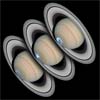
|
 |
NASA's twin Mars rovers continue exploration
NASA's Spirit rover found a new class of water-affected rock, while its twin, Opportunity, finished inspecting its own heat shield and set a new martian driving record. The rovers successfully completed their three-month primary missions in April 2004 and are working on extended exploration missions.
 FULL STORY FULL STORY
 |  |

|
 |
Outsider moon
Reflected light from Saturn dimly illuminates the night side of the cratered moon Mimas in this Cassini image. Above, the outer edges of the planet's main rings show some interesting details. Several thin ringlets comprising the F ring are nicely visible, and the bright core of the ring displays a few twisted knots.
 FULL STORY FULL STORY
 |  |

|
 |
Hear the sounds from Huygens' descent to Titan
Scientists have produced an audio soundbite that captures what the Cassini orbiter heard from Huygens as the probe descended on Titan on Jan. 14. The sounds may not be music to everyone's ears, but they're beautiful, interesting and important to investigators who are reconstructing the probe's exact position and orientation throughout its parachute dive to Titan's surface.
 FULL STORY FULL STORY
 |  |

|
 |
|
Read our earlier news archive page.
|



